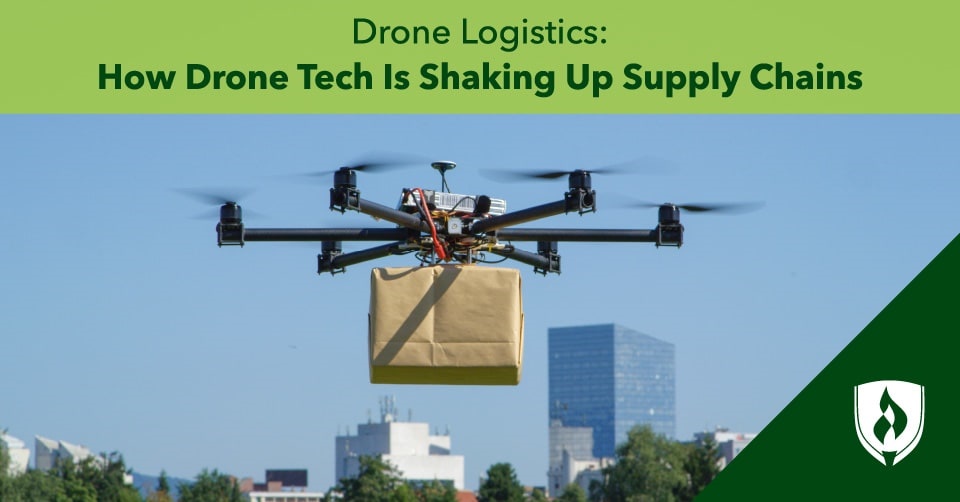
Have you ever received a package that was delivered by a drone? While the answer to that question may currently be a no, that could soon change. More and more companies like Amazon® and Walmart® are beginning to invest in more serious drone usage.
“Drones are emerging as a cost-effective solution for businesses to transport their goods, especially when the goal is to deliver packages to far-off locations,” says Marcus Astin, COO of Pala Leather.
The potential for wider-spread adoption of drone usage is leading to sunny forecasts for the technology. Fortune Business Insights predicts that the commercial drone market is going to grow from 8 billion USD in 2022 to 47 billion in 2029.1 There is no getting around it—drones are likely here to stay in the logistics industry and are actively becoming a bigger and bigger part of it. Those who are forward-thinking in this industry would be wise to improve their understanding of how to implement drone use more productively.
Let’s take a look at how drones are commonly used, their benefits and some of the downsides keeping the industry from completely taking over.
How are drones used in logistics?
So how exactly are drones being used in logistics? When people think of drone logistics, they might picture package deliveries. But companies can utilize this technology in many different ways. Astin’s company uses drones as an inventory assessment tool, getting visual images of the leather goods and monitoring the stock levels of everything they sell. “The drones are loaded with software that maps the facility and tracks the inventory. The drone operators can then compare the data from their drone viewings to the physical inventory counts to verify that all goods have been located.”
Here are five of the most common current drone uses in logistics:
- Delivery of packages
- Inspecting infrastructure
- Security surveillance
- Collection of videos and images
- Scanning of pallets inside distribution centers
As the development of drone technology is still in its nascent stages, the various uses of drones are only going to continue to grow. The sky is, quite literally, the limit as businesses devise and test new use cases for drone technology
Benefits to drone logistics
If some of the biggest companies in the world are incorporating drones into their logistics process, there must be good reason. Consider the possibilities of these benefits for a company.
Projected financial savings
The main reason companies use drones is the amount of money they can save. Forbes® reports that in one example, drone deliveries were found to be about 90 percent less expensive than deliveries through a car-based service.2 The subject of this report was an Irish company called Manna® that is running live deliveries in the city of Galway, Ireland. So far, Manna has made a ton of progress and had success in implementing its drone delivery service throughout the city of roughly 40,000 people. Based on this success, they’ve received licensing throughout the European Union and Canada. For Manna and other companies, saving money is just the start.
Speed and efficiency
Any supply chain tool that increases speed with minimal drawbacks will be immensely valuable. If companies can automate processes with drones, that saves time and lowers the risk of errors. “Since we started using drones in our operations, I noticed that our company operated more efficiently and effectively by saving money on shipping costs, reducing emissions and increasing customer loyalty as well,” Astin says.
One report predicts that a growing demand from e-commerce will result in 36 percent more delivery vehicles in inner cities by 2030.3 If more and more delivery trucks are clogging up the streets causing traffic, deliveries are going to become that much slower. A company flying neatly overhead with drones will have much happier customers. Especially when you begin to look at forecasts for big cities, the increased demand for products is going to need creative solutions to keep up with demand.
Remember Manna? They report that when delivering food to people in Galway, the average delivery time is two minutes and forty seconds.2 You can imagine the speed and efficiency upside that these kinds of deliveries would bring when produced on a massive scale.
A greener solution
When a company shifts to electric drones, the company's carbon footprint will decrease significantly. Resource Systems Group (RSG®) conducted an independent study comparing the amount of CO2 emitted from a drone versus a car and delivery vehicle. The study found that delivery vehicles emitted 26 to 28 times more CO2 than drones, a rather staggering number when you consider the number of deliveries that are done every day.4 While there is a caveat that drones will generally have a much smaller carrying capacity, they can provide a less resource-intensive option for smaller “last mile” deliveries.
Accessibility
One of the other potential benefits of drone usage in logistics is the ability to reach more places than before. Drones have been used to deliver medical supplies in typically difficult-to-reach areas like the Democratic Republic of Congo, island communities in Scotland and remote First Nations communities in Canada. Harder-to-reach people and places can be much more easily accessed by drones—and that can potentially save lives.
Reduced labor costs
One of the biggest benefits for companies will be how drones affect labor costs. Business Insider® predicts that drones could replace $127 billion dollars worth of human labor across various industries.5 With new technology and automation comes the ability to do things faster and with fewer people, and in the case of drones, in an environmentally safer way.
Downsides to drone logistics
While more and more companies are beginning the process of using drones, there are good reasons why drones haven’t completely taken over.
Initial investment costs
In the long term, drones have the potential to save organizations money. But the initial investment cost can be tough to swallow, particularly at this stage of early adoption. Some of the high-ticket elements are the cost of drones, batteries and finding skilled labor for those in charge of monitoring and maintaining the drones.
Amazon, for example, has invested $2 billion into developing its drone program. While that figure also reflects a huge amount of research and development time and funding that won’t apply to all businesses as the technology matures, there’s certainly a high initial financial barrier at the moment.
Weatherproofing and handling the elements
Drones are more susceptible to weather-related problems than other shipping methods. Whether it is high winds, cold weather freezing the batteries or any form of precipitation leaking into the drone over time, drones need more development and protection against the weather to be reliable deliverers in the timetables most companies desire.
Expensive repairs, lost items and public safety are all at stake with this consideration. Drone manufacturers are faced with the challenge of providing improved durability and safety features while trying not to sacrifice too much of the speed and environmental improvements that make these tools an appealing option in the first place.
Regulatory challenges
The legal landscape governing the use of drones and public safety is not uniform across the globe. With the potential for thousands of autonomous drones roaming a city’s skies, there’s a clear need for agreed-upon standards at the federal and state levels in the U.S.—and that’s a step that has yet to be fully ironed out.
Drone logistics are becoming a common part of business
The dream of drones changing the business of logistics is an optimistic one. Companies have the potential to save money, increase speed and efficiency, and reach new parts of the world—all while reducing their carbon footprint. The dream still has steps to become a lived reality, but that reality comes about when innovators continue to turn the wheel of progress. If you are one of those people and are interested in learning more about this kind of career, check out “7 Things You Need to Know About a Career in Logistics.”
Related Articles:
1“Unmanned Systems – Commercial Drone Market,” Fortune Business Insights, May 2022, [accessed August 2022], https://www.fortunebusinessinsights.com/commercial-drone-market-102171.
2John Koetsier, “Drone Delivery Is Here Today, and It’s 90% Cheaper Than Car-Based Services,” Forbes, August 18, 2021, [accessed August 2022] https://www.forbes.com/sites/johnkoetsier/2021/08/18/drone-delivery-is-live-today-and-its-90-cheaper-than-car-based-services/.
3Thomas Deloison, et al., “The Future of the Last-Mile Ecosystem: Transition Roadmaps for Public- and Private-Sector Players,” World Economic Forum, January 2020, [accessed August 2022], https://www.weforum.org/reports/the-future-of-the-last-mile-ecosystem.
4Justin Culp, “Calculating the Climate Cost of Drone Delivery,” RSG, March 16, 2020, [accessed August 2022], https://rsginc.com/insights/calculating-the-climate-cost-of-drone-delivery/
5Chris Weller, “Drones Could Replace $127 Billion Worth of Human Labor,” Business Insider, May 11, 2016, [accessed August 2022], https://www.businessinsider.com/drones-could-replace-127-billion-of-human-labor-2016-5.
Amazon is a registered trademark of Amazon Technologies, Inc.
Walmart is a registered trademark of Walmart Apollo, LLC.
Forbes is a registered trademark of Forbes, LLC.
Manna is a registered trademark of Manna Drones Limited.
RSG is a registered trademark of Resource Systems Group, Inc.
Business Insider is a registered trademark of Business Insider, Inc.




